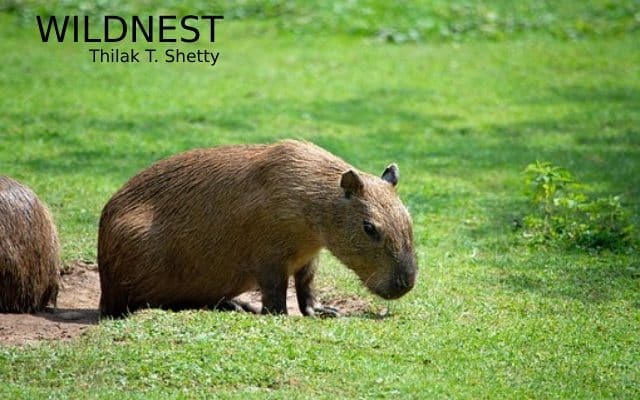The capybara or greater capybara is a giant cavy rodent native to South America. It is the largest living rodent and a member of the genus Hydrochoerus.
The capybara has a heavy, barrel-shaped body and short head, with reddish-brown fur on the upper part of its body that turns yellowish-brown underneath. Its sweat glands can be found in the surface of the hairy portions of its skin, an unusual trait among rodents. The animal lacks down hair, and its guard hair differs little from over hair.
Adult capybaras grow to 106 to 134 cm in length, stand 50 to 62 cm tall at the withers, and typically weigh 35 to 66 kg, with an average in the Venezuelan llanos of 48.9 kg. Females are slightly heavier than males. Capybaras have slightly webbed feet and vestigial tails. Their hind legs are slightly longer than their forelegs; they have three toes on their rear feet and four toes on their front feet. Their muzzles are blunt, with nostrils, and the eyes and ears are near the top of their heads.
Capybaras are semiaquatic mammals found throughout all countries of South America except Chile. They live in densely forested areas near bodies of water, such as lakes, rivers, swamps, ponds, and marshes, as well as flooded savannah and along rivers in the tropical rainforest. They are superb swimmers and can hold their breath underwater for up to five minutes at a time. Capybara have flourished in cattle ranches.
Capybaras are herbivores, grazing mainly on grasses and aquatic plants, as well as fruit and tree bark. They are very selective feeders and feed on the leaves of one species and disregard other species surrounding it. They eat a greater variety of plants during the dry season, as fewer plants are available. While they eat grass during the wet season, they must switch to more abundant reeds during the dry season. Plants that capybaras eat during the summer lose their nutritional value in the winter, so they are not consumed at that time. The capybara’s jaw hinge is not perpendicular, so they chew food by grinding back-and-forth rather than side-to-side. They also regurgitate food to masticate again, like cud-chewing by cattle. As is the case with other rodents, the front teeth of capybaras grow continually to compensate for the constant wear from eating grasses their cheek teeth also grow continuously.
Capybaras are known to be gregarious. While they sometimes live solitarily, they are more commonly found in groups of around 10–20 individuals, with two to four adult males, four to seven adult females, and the remainder juveniles. Capybara groups can consist of as many as 50 or 100 individuals during the dry season.
When in oestrus, the female’s scent changes subtly and nearby males begin pursuit. In addition, a female alerts male she is in oestrus by whistling through her nose. During mating, the female has the advantage and mating choice. Capybaras mate only in water, and if a female does not want to mate with a certain male, she either submerges or leaves the water. Dominant males are highly protective of the females, but they usually cannot prevent some of the subordinates from copulating. The larger the group, the harder it is for the male to watch all the females. Dominant males secure significantly more mattings than each subordinate, but subordinate males, as a class, are responsible for more mattings than each dominant male. The lifespan of the capybara’s sperm is longer than that of other rodents. Capybara gestation is 130–150 days, and produces a litter of four young on average, but may produce between one and eight in a single litter. Birth is on land and the female re-joins the group within a few hours of delivering the new-born capybaras, which join the group as soon as they are mobile. Within a week, the young can eat grass, but continue to suckle—from any female in the group—until weaned around 16 weeks. The young form a group within the main group.
In the early 2020s, capybaras became a growing figure of meme culture due to many factors, including the disturbances in Nordelta, which led to them being comically postulated as figures of class struggle. Also, a common meme format includes capybaras in various situations with the song “After Party” by Don Toliver, leading to a tremendous growth in popularity. Due to a lyric in Toliver’s song, capybaras are also associated with the phrase “Ok I pull up”.

















